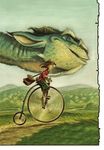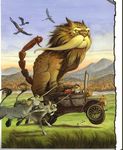BY TONY DITERLIZZI READING GROUP GUIDE FOR - AND - TONY ...
←
→
Page content transcription
If your browser does not render page correctly, please read the page content below
About the Books
When Kenny Rabbit learns that a real dragon may be living on his family’s property, he sets out in a homemade suit of armor
to vanquish the beast. Instead of a fire-breathing, princess-devouring scourge, he encounters Grahame, a dragon with a love for
poetry and crème brûlée. The unlikely pair become fast friends, and all is well until the townspeople discover that a dragon is
among them. In the follow-up, Kenny & the Book of Beasts, much has changed for Kenny Rabbit. No longer an only child,
Kenny has twelve new sisters and lots of new responsibilities. He also has a whole group of friends, but lately they haven’t been
hanging out very much. Even his friendship with Grahame is threatened when an old pal of Grahame’s starts monopolizing
Grahame’s time. Kenny must learn not only what it means to have a friend, but how to be a good friend.
Discussion Questions
1. In the introduction to Kenny & the Dragon, readers learn that Kenny’s classmates describe him as “kind of out there.”
Describe your understanding of Kenny. What are his strengths and weaknesses? What does the phrase “kind of out there”
mean to you, and do you think it is a fair or appropriate way to describe Kenny? Explain your answer. How do you think
Kenny would describe himself?
2. Reread chapter three, “Grahame Like the Cracker,” in which Kenny meets Grahame the dragon. What does Kenny expect
to encounter once he locates the dragon? Why do you think he has that idea in his head? What does he actually experience
once he and Grahame begin to talk to each other? What does Kenny learn in this chapter that changes his previous attitudes
about dragons? Describe a time in your life when a situation turned out differently from what you expected. How did it
make you feel?
3. When Kenny learns that the townspeople want to exterminate Grahame, he realizes that he must act to protect his friend.
Why do the townspeople want to kill Grahame if they don’t even know him? Upon learning the news, why is Grahame
unconcerned about people wanting him dead? How would you explain the “river-stone-stomach” feeling that Kenny is
experiencing?
4. According to Google English dictionary, sensationalism is “the use of exciting or shocking stories
or language at the expense of accuracy, in order to provoke public interest or excitement.” How
does the news that a dragon is in their midst create sensationalism among the townspeople?
Cite examples of sensationalism in chapter six. If the townspeople actually got to know
Grahame, how might they describe him?
5. Discuss the meaning of George’s advice for Kenny: “In life, you must always plan your moves.
Think before you act. Move toward a favorable outcome.” How does this advice guide Kenny
in his task of saving Grahame from extermination? Can you name other occasions during
either book when thinking before taking action is important? Give an example from your own
experiences.
6. Throughout Kenny & the Dragon, it becomes clear that people and dragons are not always what they seem. When Kenny
discovers that his friend George is a famous dragon slayer, he realizes it’s up to him to keep George from killing Grahame,
or vice versa. Why doesn’t Kenny tell George about Grahame when he first learns that his old friend is a knight? When
Grahame learns of the royal order to slay him, he scoffs, telling Kenny, “‘What does he know? When was the last time he sat
down and talked to a dragon.’” Why is it important to get to know people before making personal judgements? How might
you work to avoid making assumptions about others?
7. After Kenny witnesses the angry mob’s hatred in the tavern, his river-stone-stomachache is “starting to melt away to
another feeling—a fiery feeling.” What do you think this “fiery feeling” represents? How does George’s willingness to talk
to Grahame and “sort something out” demonstrate his friendship with Kenny? And how does it conflict with what others
expect him to be, say, and do?
8. In Kenny & the Book of Beasts, some time has passed since Grahame and George staged a battle for the townspeople. How
has life changed for Kenny, and how have these changes begun to make him feel? How do his family responsibilities affect
his friendships?9. Kenny dreams of hitting the open road, imagining that his friends and family will miss him when he leaves. What is
making Kenny feel alone? Have you ever felt this way? If so, what did you do to share your feelings with others, or to
change your situation?
10. When Kenny confides to his father that he’s upset about George leaving to work for the king, his father says, “‘That’s the
thing about change, son. It happens whether you like it or not. You can spend yer time fightin’ it, or you can jus’ accept it.
... Sometimes a bit of good comes with change.’” How do you feel about this statement? How might change bring good
things? Describe a time in your life when an unexpected or unwanted change turned out to be a positive experience.
11. Discuss Eldritch Nesbit. How does she reveal her hatred for what she describes as “monsters”? Why might it be dangerous
to claim that one “knows everything”? Explain your answers.
12. How does Eldritch attempt to sow doubt among the friends gathered at the dinner table? Why do you think she is trying
to convince the king that Grahame is a threat? Discuss Eldritch’s reply to Kenny, who says that they want everyone to
know the truth about dragons and other mythical creatures: “‘Facts to you are fiction to others. We see only what we want
to see . . . . Are you a friend? Foe? Ruler? Subject? A monster or a savior? It is all in the eyes of the beholder.’” Discuss the
differences between facts and opinions. How does Eldritch’s personal opinions about mythical creatures threaten the facts?
13. When Dante the manticore comes to live with the Rabbit family, Kenny becomes jealous and resentful of the lionesque
creature. Why does Kenny feel threatened by Dante’s friendship with Grahame? Recall a time when you were excluded by
a friend or group, or your circles of friends were changing. How did it make you feel? If you could go back to that time,
what would you do differently? What advice would you give to Kenny?
14. How does Eldritch take advantage of Kenny’s anger and hurt feelings to advance her evil plan?
15. When Dante tries talking to Kenny, Kenny is unkind and rejects him, calling him a “beast.” Dante replies, “‘But do your
words not sting? Is there not a biting tone in how you treat those who care about you? Are you not also capable of vicious
things?’” How do Kenny’s emotions get in the way of listening to what Dante is trying to say? How does his anger and
jealousy cause him to place both Dante and Grahame in danger?
16. Why does Kenny turn down the king’s offer to rewrite the bestiary?
17. Friendship is an important theme in these books. Discuss examples of how the power of friendship overcomes
misunderstanding and hatred.
18. How does Kenny change over the course of the two books? What valuable lessons does he learn about
friendship, responsibility, and change? Where do you think his next adventure might take him?
19. Tolerance and its opposite, intolerance, are important aspects in both stories. What does it mean
to be tolerant? How do Kenny, his parents, Grahame, George, and the royals show tolerance for
those who are different from themselves? What characters across both stories are intolerant? Are
there any characters who are both? Discuss specific examples from both books.
20. The importance of reading, learning, and pursuing knowledge and truth appear throughout
Kenny & the Dragon and Kenny & the Book of Beasts. What messages do you think the author is
trying to convey?
21. How do both books celebrate the tradition of storytelling?
22. The author dedicates Kenny & the Dragon to his “little girl,” Sophia, with the message: “It’s what’s
on the inside that counts.” Now that you have read and discussed both stories, what does this
message mean to you? How do you think it’s reflected in the characters?Extension Activities
1. Kenny & the Dragon is a retelling of “The Reluctant Dragon” (1898), a short story for children written by
Kenneth Grahame. After reading Kenny & the Dragon, have students read the story that inspired the novel.
Afterward, lead a class discussion about aspects of the short story that they see incorporated into the Kenny & the
Dragon books. Ask them to think about what stories inspire them.
2. Throughout both novels, readers learn about a variety of mythical creatures, such as hippogriffs, hydras, unicorns,
and, of course, dragons. Help students learn more about bestiaries by allowing them to visit these sites, which the
author also used for research: The Medieval Bestiary (Bestiary.ca) and T.H. White’s The Book of Beasts (Digital.
Library.WISC.edu/1711/dl/HistSciTech.Bestiary). Challenge students to use these sites for inspiration and
discussion before creating their own original creatures composed of at least three different animals. Collect all
finished artwork in a class bestiary.
3. One of the things that Grahame and George have in common is their love of poetry. Poets such as Brontë,
Wordsworth, and Whitman are referenced in the texts. Write the following Walt Whitman passage on the board:
“Happiness . . .
not in another place but this place,
not for another hour but this hour.
Ask students why they think the author included this line in the opening of Kenny & the Book of Beasts. Next,
ask students to explain what the line means to them. Do a class brainstorming exercise in which they describe
their definitions of happiness. Write student responses on chart paper. Then give students time to write a three- to
five-line poem about happiness.
4. In Kenny & the Book of Beasts, Kenny and Grahame have a conversation about friendship as they gaze through
a telescope at the night sky. Dante interrupts the conversation, asking, “Have you identified any constellations?
Leonis Minoris or perhaps Draco?” Share a star chart with the class and identify these constellations. Give
students time to explore other constellations, focusing on how they are identified. Use this link to get started:
SpacePlace.NASA.gov/Search/Constellations/.
5. In both stories, it is assumed that Grahame is the last of his kind. Lead
students in a study of animals currently on the endangered species list.
Students can work independently, with a partner, or in a small group
to gather and present information to the class about an animal that is
bordering on extinction.
6. The author begins Kenny & the Dragon with the phrase “Many years
ago . . .,” changing the expectation that readers might have about a
fairy tale always beginning with the words “Once upon a time.” Have
students write a short epilogue to the series, picking up where the
author left off. Challenge students to begin their story in an original
way while still establishing the time and setting.
This guide was created by Colleen Carroll, literacy specialist, curriculum writer, and children’s book author. Learn more about
Colleen at ColleenCarroll.us.
This guide has been provided by Simon & Schuster for classroom, library, and reading group use. It may be reproduced
in its entirety or excerpted for these purposes. For more Simon & Schuster guides and classroom materials, please visit
SimonandSchuster.net or SimonandSchuster.net/TheBookPantry.You can also read























































